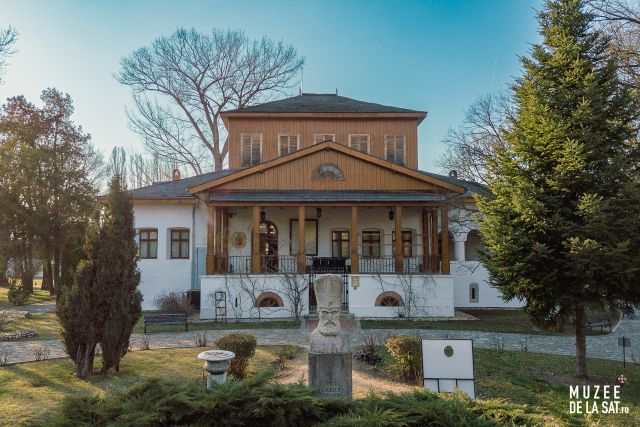Countryside Museums
Discover the only Romanian online platform devoted to countryside museums

Daniel Onea, 29.06.2023, 13:40
The only Romanian online platform devoted to countryside museums takes users around over 50 museums
across rural Romania. Each museum tour is an interactive 3D tour, produced with
high-performance equipment and integrated with Google Street View, Google Maps
and Google Earth.
The platform Muzee de la sat is
aimed at promoting the Romanian village and museums in the countryside using
state-of-the-art technology so as to engage the young, the project manager
Ionuț Teoderașcu explains:
Ionuț Teoderașcu: This project, muzeedelasat.ro, started
nearly 2 years ago. First we scanned and visited museums in Moldavia, in the
east of the country, because the project is implemented in stages, by region.
So we started with Moldavia and then moved to Wallachia and recently, about a
month ago, we reached Dobrogea. We’re taking it step by step. So far we have
explored over 10,000 km, Dobrogea included, and more than 70 museums. The
platform currently includes 53 museums, and we are working on the materials for
the museums in the 2 counties in Dobrogea, Tulcea and Constanța.
The only online platform devoted
to museums in the countryside places great emphasis on the rural and the
traditional, as Ionuț Teoderașcu adds:
Ionuț Teoderașcu: In a first section of the website we
introduce ourselves and present our goal, which is exploring the entire
territory of Romania and see all the museums in rural communities. Obviously,
we have an interactive map of Romania, featuring the counties that we have
covered so far. When users select a county, a tab opens listing the museums in
that county that can be explored using the virtual tour on our platform. For
instance, if we choose Iași, we find 2 museums: the Alexandru Ioan Cuza
Memorial in Ruginoasa and the Cucuteni Museum. The website is translated into
English as well, which is very important since we target not only Romanian
nationals, but foreigners as well. We had extensive media coverage, so those
interested in finding out more about the project may read about the story
behind it.
The eligibility criteria included
safety and functionality. A museum must be hosted in an adequate building and
opening hours must be complied with, so that tourists who plan to visit it may
be sure that they can do so. The response from both users and museum curators
during these 2 years has been positive, according to Ionuț Teoderașcu.
Ionuț Teoderașcu: Museum curators told us this kind of
promotion was very helpful, because users checked out the museum on the
internet and then visited the respective museums in person as well. Many times
tourists said they saw the virtual tour on our platform and were persuaded to
come visit the museum. Users are delighted. For those cannot travel there, this
is a very good way to see something new and to explore these museums from the
comfort of their home. There are cases of people in poorer health, who are
unable to travel, so we facilitate this contact between rural culture and urban
users who explores the world on their tablets, phones or laptops.
Ionuț Teoderașcu, project manager with muzeedelasat.ro,
has chosen two of the objectives presented to the public with the
recommendation to visit them. The list is very big and the choice subjective
but you can get a clear picture of the objectives proposed.
Ionut Toderascu: I have recently discovered when I have been to Dobrogea, the preserved traditional
household in Enisala, the Tulcea county, where we can see a traditional
architecture specific to North Dobrogea, with various tools on the premises. We
can see how households had been built, for instance, on stone foundations with
adobe walls. This is a very beautiful household with vivid colours, but also
interesting, especially for foreign tourists. Here tehy can discover a new
culture and see how people used to live in the past. This household, for
instance had two houses: the main house with two rooms, the living room and
what they used to call the good room or the beautiful room, where events were
being staged, the dowry stored etc. Not
everybody was allowed into that room. Another museum can be found in the region
of Moldavia. It is the Palace of Alexandru Ioan Cuza in Ruginoasa, the county
of Iasi, and it’s completely different from a traditional peasant household of
course. This is like the name says, a palace, which was the summer residence of
Romania’s ruler Alexandru Ioan Cuza. The furniture here is very beautiful and
interesting. It was purchased by the ruler’s wife, Elena Cuza, from Paris. We
are speaking about a different period of time here and, of course, another type
of village museum. Being located in Ruginoasa, it is also a village museum and
can be explored on our website.
The iniatiators of this project intend to cover the
entire Romania and get as many visitors as possible. This large-scale project
has also a social component:
Ionut Toderascu: We are also going to the disadvantaged areas of Romania with VR galsses
and show these museums to children who have probably never been to a museum.
They are using these headsets and go around the museums by means of the
joysticks. They are asking us things and are practically exploring the museums
for themselves. We’d like to reach out
to these children and show them the cultural value of the village, the museums,
but at the same time to develop the platform and go further to other counties
to see other museums, scan them and complete Romania’s interactive map.
By using this interactive map,
depending on the area you are visiting,
you can create your own route so that you may visit as many of these
museums as you can and get a clear picture of the rural life. (AMP&bill)






























